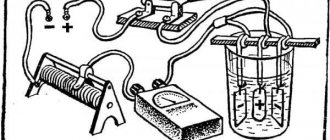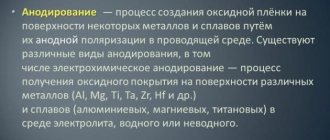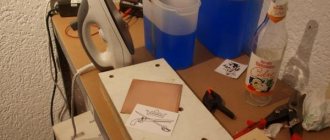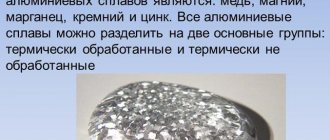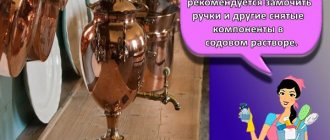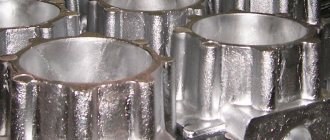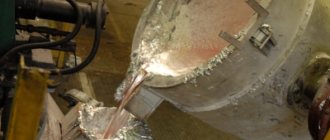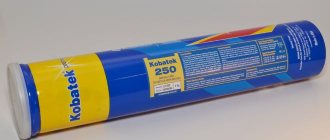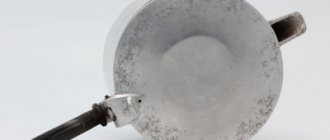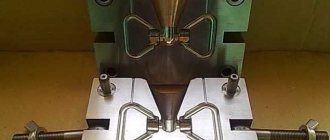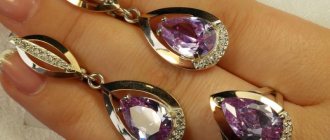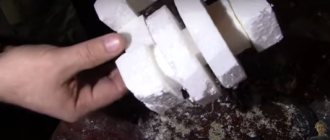Coloring methods
There are two main ways of painting aluminum products: with anodizing and aniline, and also without it, but using metal enamel and primer.
Thanks to these methods, you can paint aluminum products with your own hands right at home. If you have not encountered anodizing before, it is a chemical process that is performed to ensure that aluminum does not oxidize and the paint adheres normally to its surface. It is this procedure that guarantees the highest quality painting both at home and in industry. However, even without it you can achieve acceptable results if you follow all the instructions. After all, anodizing large objects with your own hands is a very, very difficult process.
Do-it-yourself anodizing
Painting aluminum surfaces using anodizing is done as follows. You will need:
- for electrolyte solution - soda and salt;
- aluminum dishes;
- current source;
- sandpaper;
- aniline and vinegar;
- degreaser.
First we need to make the electrolyte. To do this, you need to prepare solutions of salt and soda. To do this, you need to mix them in one vessel in a proportion of 9 parts salt to 1 part soda. Mixing must take place in a glass container!
We process the product to be painted with sandpaper and degrease its surface. After this, it should be dipped into water, being careful not to touch the surface of the profile with your hands. You need to pour an electrolyte solution into an aluminum dish and put the object to be painted in it. Next, connect the current source with the positive pole to the product, and the negative pole to the cookware. Let's leave it for 2 hours.
After this, you can proceed to painting with aniline dye. To prepare it, you need to add 1 ml of vinegar, 15 g to a liter of water. dye and heat about 75-80 degrees.
Next, we place the object to be painted in this solution for about a quarter of an hour. Now you know how to paint anodized aluminum.
Alternative technology
How to paint aluminum without anodizing at home? You will need:
- sandpaper;
- primer;
- epoxy or acrylic paint for metal (aerosol is more suitable than standard powder paint if painting is done at home);
- degreaser.
First you need to properly sand the product. Next, the profile should be degreased. After this, you need to start priming the profile surface as quickly as possible. After complete priming, you can begin applying paint. It is better to use an aerosol.
After painting, leave the profile to dry for 6 hours, after which its surface can be coated with an additional layer of varnish. This is exactly how painting aluminum at home ends up if you do it yourself.
But there is an even easier way to dye at home! To implement it, you just need to sand the product well and then degrease it. Afterwards you need to apply a special enamel paint on it. Be careful to follow all instructions on the enamel can exactly! The painting will be finished after drying.
Painting with powder paint
If you have the opportunity to use some production tools for painting, then an excellent option for you would be to give the aluminum a new color using powder paint.
This method of painting requires treating the part with a special solvent that will not leave previous layers of paint on the object. Next, a powder coloring agent is applied. This is done evenly and carefully so that the color is rich and permanent.
Immediately after applying powder paint, the part will not seem too perfect, but then the item must be placed in a special industrial heat chamber.
There, the part and the coloring powder are heated to a high temperature, due to which the powder begins to melt, uniformly coloring the surface to which it is applied.
This method of painting aluminum parts is the most durable and reliable, because this paint is of high quality. But carrying out a similar process at home is more than difficult.
Painting non-ferrous metal surfaces is a difficult process, but if you approach it competently, it can be easily accomplished even at home. The main thing is to follow the rules!
Method 1
In order to carry out the procedure of anodizing and painting aluminum you will need:
- salt, soda, boiled water for preparing an electrolyte solution - aluminum container in which our part or product will fit - fine sandpaper - current source (about 2A and 12V) - acetone or kerosene for degreasing - aniline dye and acetic acid for preparing paint
Instructions for painting aluminum with anodizing
1 First we need to make electrolyte at home.
To do this, you need to prepare two saturated solutions - salt and soda. We add salt to one container with boiled water, soda to another, stir, add more, stir again and do this for 25-30 minutes so that the solutions are maximally saturated with salt and soda. Leave them for another 15-20 minutes, filter and mix in a GLASS CONTAINER in the proportion of 9 parts of soda solution to 1 part of salt solution 2 Take our aluminum part or product and carefully treat the surface with fine sandpaper 3 Degrease the surface using acetone, kerosene or a special liquid for degreasing 4 Rinse the aluminum part in water. After rinsing the part in water, try not to touch it with your hands, as your hands may leave stains on the surface that will affect further processing of the product. 5 We pour the electrolyte we have prepared into an aluminum dish - a basin or pan - and place our aluminum product there. To start the anodizing process, we connect the current source with a plus to our product, and a minus to the aluminum container. As a current source, you can take a car battery or an adjustable rectifier (the current should be about 2 Amperes, the voltage should be about 12 Volts). Anodizing should be carried out within 1.5 - 2 hours, during which time our aluminum product will acquire a pleasant bluish-gray tint. 6 How to paint aluminum? Anodized aluminum should be painted with an aniline dye solution. To prepare such a solution, you need to add 15 grams of dye, 1 ml of acetic acid to 1 liter of water and heat it to 70-80 degrees. We immerse our aluminum product in the dye solution for 10-15 minutes, the longer we keep the product in the dye solution, the more saturated and dark its color will be after painting Zinc-aluminum paint for any metals
Anti-corrosion zinc primer for aluminum
Paint “Cold galvanizing” zinc 96%
Electrochemical painting method
It is better to paint aluminum using the electrochemical method, but it is not accessible to everyone and is quite labor-intensive. The process goes like this: first, electrochemical oxidation is performed, then a primer is applied, then paint. Before oxidation, the surface is chemically cleaned. After oxidation, a protective oxide film is obtained on top. To increase the resistance of such a film to corrosion, before priming, the part is placed in a chromium solution.
The oxidation process is performed electrochemically or chemically.
With the electrochemical method, the appearance of an oxide layer is achieved by passing current through an acidic electrolyte solution. And after that they are treated with chromium and covered with paint or varnish.
During chemical oxidation, aluminum is treated in special solutions of sodium bichromate, chromic anhydride, and potassium fluoride.
Read also: Weight of a steel cylinder
At home, oxidation is quite difficult. It is necessary to have certain skills and strictly adhere to safety rules when working with chemicals.
After obtaining a layer of oxide by oxidation, you can begin painting the aluminum. To do this, purchase aniline dyes in the store - powders used for dyeing woolen fabrics. The aluminum part is placed in a hot (50-60°C) solution of aniline dye and kept there for no more than 20 minutes. After painting, the part is removed from the water, dried and coated with colorless varnish.
Dyeing process
Thanks to the coloring that immediately follows anodic oxidation, the parts acquire the final color intended for them. An oxide film made under the right conditions can absorb dye molecules into its pores. As a rule, coloring occurs in an aqueous environment (if possible in clean water) at a temperature of 40-60 0C, immersion time is 5-30 minutes. The concentration of the dye depends on the desired color depth (color intensity).
The next factor that affects the dye absorption ability is the pH of the bath. This value varies between pH 4 and pH 7. Chemicals that can be used to change the pH: - acetic acid to lower the pH, - sodium hydroxide to increase the pH.
To ensure uniform coloring, especially of large areas, it is necessary to ensure continuous circulation of the dye in the bath. This is achieved by direct supply of oil-free air or mechanical circulation of the coloring solution.
Painting aluminum at home
If you need to paint aluminum at home, you should follow all painting steps very clearly and consistently. An aluminum product must first be cleaned, then degreased and primed, and only then applied paint. The quality of the primer and paint is of great importance in this process. It is important to choose a good primer “for stainless steel, galvanized coatings and aluminum.” Special two-component epoxy/polyester paints can be used for painting. Use sandpaper to remove all old paint and white powder. Apply the first coat of primer as quickly as possible before the aluminum becomes dull. The oxidation process of aluminum in air occurs very quickly, so it is important to apply the first layer of primer as quickly as possible, before oxides form. After applying the first layer, wait the time specified in the manufacturer's instructions. When applying the second layer, there is no need to rush.
Even if the primer package says that no surface cleaning is required for its application, it is better to do so. Freshly cleaned aluminum will adhere better to paint. The sooner painting is done after mechanical cleaning, the better the adhesion.
How to paint aluminum yourself
The process of painting aluminum at home will not be easy. This is a complex event that requires compliance with all conditions. Even with minimal damage or scratches, the applied coating will easily peel off the metal. Only specialized paints and primers are used for aluminum. However, the anodizing process is most often still necessary.
There are various DIY painting methods. But we cannot say that the painting is carried out with very high quality, since the procedure must be carried out under appropriate conditions. This is explained by the properties of aluminum, which is easily oxidized by air.
The ideal painting method would be anodizing under special conditions and applying paint using professional equipment. It is in this case that the surface receives a high-quality and durable coating.
It will be no secret for any specialist who knows the properties of aluminum that there are 3 ways to paint it without specialized equipment. But you still can’t do it without special devices or reagents. Using regular paint and primer will get you nowhere. Only these three methods are effective:
- Powder painting;
- Anodizing or using aniline dyes;
- Use special primers or enamels, having previously degreased the surfaces. This method is also called “painting without anodizing.”
Integral painting of aluminum
With integral coloring, the anodic oxide coating is colored by itself during the anodizing process. Coloring occurs either by anodizing conventional aluminum alloys in solutions of special organic acids or by conventional anodizing of special aluminum alloys in sulfuric acid.
The oxide layer can be painted in color from light “bronze” to black, depending on its thickness. Since this method requires complex and exotic acids or similar alloys, it has almost completely been replaced by electrolytic painting, at least in products used in construction.
Source: TALAT 5203
Powder coating
Powder painting of aluminum involves treating the metal surface with special chemical compounds, and then applying a layer of powder paint. The part is then treated with high temperature, causing the dye to melt, ensuring the strength and durability of the polymer layer. The advantage is a wide range of colors, i.e. you can create a golden color or chrome without any problems. Defects that arise can be easily removed with a special coloring pencil. The widespread use of the method eliminates the need for specific equipment.
Powder painting is carried out in two stages. The first is the use of special solvents to remove previous layers. The second is treatment with a coloring composition. If everything was limited to this, then there would be no difficulties.
However, in order for painted, for example, alloy wheels or profiles to acquire the required attractiveness and be reliably protected, their surface must be additionally heated. This can be done using a thermal camera. In it, prepared surfaces are treated at high temperatures so that the applied powder paint spreads in an even, durable layer.
It is not always possible to use powder coating of aluminum. The price of specialist help can also be considerable. Therefore, for self-processing, you can use other staining methods.
Application
Sanodal® dyes are used in such industries as aviation, auto, shipbuilding and instrument making, as well as in the production of consumer goods. Sanodal® stains can be used to coat aluminum surfaces of architectural structures, optical instruments, household utensils, indoor and outdoor decoration products, aluminum furniture and fittings, as well as external building elements such as glazing moldings, structural panels, stained glass, window and door blocks.
Anodizing
This method involves applying a protective layer using the galvanic method. The most durable coating is obtained using this method. Most often, other methods achieve only temporary results.
Anodizing is a process of improving the appearance and providing protection against oxidation. Upon completion of the procedure, the metal can be painted with the necessary material, for example, aniline paint.
To work you will need the following:
- Salt, soda - to prepare the electrolyte.
- Aluminum cookware.
- Current source.
- Sandpaper.
- Vinegar.
- Aniline.
- Degreasing agent.
This electrochemical method requires strict adherence to operating technology. It looks like this step by step:
- To begin, prepare your own electrolyte solution from salt and soda. The required volume of water to fully accommodate the workpiece should be determined in advance.
- The water is divided into 2 equal portions, from which a solution with soda and salt is prepared separately. Then they are mixed. The percentage should be approximately: 9 parts salt to 1 part baking soda. Mix in a glass container.
- After this, the part must be thoroughly sanded and degreased (for example, with acetone).
- Immersed in water. It is advisable not to touch the prepared surface. Then the workpiece is placed in an aluminum vessel with a solution.
- The current source is connected. “Plus” - for the part, “minus” - for the dishes. The power source can be a 12 V car battery with a current of 2 A. The current density should be based on a calculation of approximately 15 mA per 1 cm2.
- It remains turned on for about two hours, or rather, until the solution turns grayish-bluish.
Read also: How to connect an old video camera to a computer
Upon completion of the process, aniline dye should be prepared with water and acetic acid. The proportions are as follows: for 1 liter of water add 1 ml of vinegar and 15 grams of paint. The composition must be heated to 75 – 80°C. This solution must be poured into a vessel with an anodized element. Many automotive and other parts often need to be painted black or other colors. This can be done quickly and cheaply in a similar way.
This method, despite its apparent complexity, is the simplest and least expensive of all. It has gained well-deserved popularity, as it allows you to obtain the most durable, water-resistant surface on such a finicky material.
Dyes for aluminum in different colors
Anyone who has at least once tried to paint aluminum knows that this process is not easy. The fact is that paints applied using the usual method do not adhere well to this material, and then during use they begin to peel off. To paint aluminum, it is necessary to use special technologies that allow the paint layer to adhere well and serve for a long time.
Aluminum is highly chemically reactive; in the open air, products made from this metal are covered with a protective oxide film.
Industrial enterprises use two methods for painting aluminum:
- Polymer (powder) painting
- Anodizing
- Aluminum painting without anodizing
Powder coating of aluminum:
Here the surface of the aluminum is treated with a special chemical and only then a layer of paint, which is in powder, is applied.
Then the product is placed in a special heat chamber and, under the influence of high temperature, the powder paint melts and the result is a durable layer of polymer coating.
Using this method it is possible to obtain a very wide range of different colors for painting aluminum coatings. If defects arise during further work, they can be eliminated using a special coloring pencil, which helps hide scratches on painted aluminum.
Aluminum anodizing:
With this method, a protective layer is applied to aluminum using the galvanic method.
Anodizing is a process that aims to improve the appearance of the metal and protect it from oxidation. After such procedures, the metal surface acquires a gray tint, and after this the product can be painted with any suitable paint.
To begin, prepare two high-concentration solutions - from baking soda and from table salt. The substances are dissolved in water for at least half an hour, stirring occasionally, then the solutions are left to settle for 15 minutes and filtered.
The anodizing process itself lasts about an hour and a half, and the part should acquire a grayish-blue coating.
After this, the part can be left in its current state or painted with a solution of aniline dye. To prepare a solution per liter of water heated to 60-80 degrees, take 1 ml of acetic acid and 15 grams of dye. The part is placed in the solution and left for 10-15 minutes. Depending on the duration of exposure, the color saturation changes.
Painting aluminum without anodizing:
To paint using this method you will need: metal primer, sandpaper, degreasing solvent, metal paint.
To begin with, the surface of the aluminum part is treated with fine-grained emery cloth. It is better not to use coarse sandpaper, since aluminum is a rather fragile metal and its surface can be easily damaged. If you do not treat the metal surface with sandpaper at all, the paint will not adhere well to the surface. Sanding with sandpaper creates microcracks and thereby promotes deep penetration of paint into the metal.
Using a solvent or acetone, treat the surface of the product for degreasing. Solvents not only remove dirt and greasy marks that make paint difficult to adhere to, but also improve adhesion.
to apply paint to aluminum to protect it from corrosion, since it is not afraid of rust.
Technical consultation
| Rhodamine C | Rhodamine J | INDIGO dye | Black for aluminum |
| Disperse black K | Dispersed red 2C | Aniline yellow | Bright blue anthrachin |
| Green K | Red F | Yellow K | Deep black for aluminum |
| Dispersed scarlet F | Disperse red | Yellow 2K | Cation blue |
| Straight orange | Alcohol soluble blue | Bright yellow | Bright green |
| Yellow 3Zh for aluminum | Yellow | Brown fat soluble | Nigrosin |
| Masterbatches | Active brown F | Active orange | Disperse blue |
| Disperse violet 2C | Acid black | green | orange 2G |
| alizarin red | Cubic bright blue | Dispersed brown | red |
| blue-green | purple 2C | purple K | For aluminum yellow |
| orange | Fat soluble yellow | green anthraquinone | red |
| Dark red | purple anthraquinone | Acid yellow | Orange 2ZH |
| Alcohol-soluble nigrosine | Scarlet 2.4ZhT | Ruby C | Black 4CT |
| Organic acid blue dye K | Dye chrome bright red 2C | cationic blue dye | magenta dye |
| methyl violet dye | alizarin red dye | organic methyl blue dye | Diamond dye |
| dark red dye F | Indulin fat-soluble | synthetic dyes | direct dyes |
| acid dyes | active dyes | yellow lightfast brand | scarlet F |
| scarlet concentrated | active turquoise dye 2 “Z” T | scarlet pigment TP | green pigment TP |
| pigment black TP | direct yellow lightfast dye “Z” X | direct yellow dye K | direct dye bright orange |
| direct scarlet dye F | dye direct pink lightfast C | direct red-violet lightfast dye 2KM | direct ruby lightfast dye |
| direct lightfast burgundy dye SM | direct lightfast burgundy dye 4ZhM | direct brown lightfast dye 2KH | direct black dye 2C |
| direct green dye 2C | direct dye dark green 2C | direct olive dye | direct turquoise dye SV-K |
| direct blue dye KU | direct blue lightfast dye KU | acid red dye 2C | acid scarlet dye |
| acid green dye 4Zh | acid blue dye 2K | acid black dye 2CH | dark brown acid dye KMSh |
| chrome black dye N | chrome brown dye K | chrome blue dye 2K | dye sovelan yellow M |
| dye sovelan orange M | dye sovelan red M | dye sovelan burgundy M | dye sovelan blue M |
| dye sovelan violet M | dye sovelan black M | dark brown dye M | dye red-brown M |
| olive dye | dye sovelan gray M | dispersed yellow dye 4 “Z” dispersed yellow dye K | disperse dye orange F |
| disperse scarlet dye 2 F | pink disperse dye 2C | dispersed red dye F | disperse red dye 2C |
| dispersed ruby dye F | ruby disperse dye 4Zh | disperse dye dark blue 2K | dispersed dark blue dye “Z” |
| disperse dye yellow-brown 2G | dispersed dye red-brown F | disperse dye dark green 2G | dispersed dye black 2K |
| dispersed dye black C | active yellow dye 2KT | active dye bright orange 4KT | active orange dye ZhT |
| active red dye ZhT | active dye red-violet 2KT | active dye red-brown 2KT | active black dye 4CT |
| active dye bright red 5СХ | fat-soluble yellow dye | fat-soluble yellow durable dye 2 “Z” | fat-soluble dye golden yellow |
| fat-soluble red dye C | fat-soluble orange dye | fat-soluble dark red dye F | fat-soluble dark red dye 5C |
| fat-soluble brown dye | oligomeric yellow dye | scarlet pigment 2C | phthalocyanine blue pigment |
| yellow transparent pigment 2 “Z” | pigment yellow 4K | green pigment grade B | golden yellow pigment durable |
| green pigment “O” | red pigment “F” | pigment red 5 “C” | pigment orange F |
| orange pigment K, burgundy varnish SK | red reinforced concrete varnish | basic green varnish | basic green varnish 5G |
| base red varnish 4C | base blue varnish K | base varnish violet 2C | ruby varnish SK |
| ruby varnish 3SK | hot pink nail polish | yellow pigment 4 “Z” | yellow lightfast pigment 2 “Z” T |
| P | white pigment TP | emerald pigment C | bright red pigment 2 “C” |
| pigment black software | bright green pigment | yellow pigment 12 “Z” |
For questions regarding purchasing Dyes for aluminum in different colors and receiving detailed advice on product properties, delivery conditions and concluding a contract, please contact our managers:
+7 +7 [email protected]»
For questions regarding the purchase of oil and lubricants [email protected]
- Catalog CONDOR OIL
- Oil catalog
- Lubricants catalog
- Liquid catalog
Place an order Request a price
Special primers and enamels
In order not to use the anodizing method, but not to reduce the quality of the created surface, you can use a special primer that provides high adhesion. To do this, the following tools and materials are needed:
- Painting equipment - brushes or sprayers.
- Sandpaper.
- Special alkyd primer.
- Suitable paint for aluminum.
- Degreasers – acetone, white spirit, kerosene.
This staining method requires some preparation. To find special dyes and primers for painting aluminum elements (bumpers, boats or corrugated sheets), you will have to study the assortment of more than one hardware store. The dye is worth buying epoxy or acrylic. For home processing, it is better to choose an aerosol than a powder dye. However, searching and purchasing materials is one of the initial stages of processing. Alternative painting of aluminum involves performing the following operations:
- Surface treatment with sandpaper. You should get a uniform matte surface. It is optimal to use sandpaper with 1200 grit.
- Removing dust and dirt.
- Degreasing with special compounds.
- Treatment with a special primer. Moreover, it is necessary to complete priming after the degreasing effect ends.
- Uniform application of paint from a can onto a primed surface. Apply in 2-3 layers with a short interval necessary for the previous one to dry.
- Drying of the part within 6 hours.
- Applying protective varnish to the dry surface.
- If necessary, polish the finished surface.
You can use a less complex version if you have a grinding machine. After careful sanding, the surface is quickly treated with special enamel. In this case, you must strictly follow the instructions for using the coloring composition. If you have the necessary materials and tools, then this method is very simple.
To carry out all the activities with your own hands, you need to tune in to quickly carry out all stages, acquire basic knowledge of chemistry and reactions, as well as available tools. To study the process in detail, you can use the video provided and study the photos, which explain all the nuances of the procedure. In this case, high-quality painting will not be difficult.
We also recommend reading:
Casting aluminum yourself at home
What is aluminum anodizing
The process of painting aluminum at home will not be easy. This is a complex event that requires compliance with all conditions. Even with minimal damage or scratches, the applied coating will easily peel off the metal. Only specialized paints and primers are used for aluminum. However, the anodizing process is most often still necessary.
There are various DIY painting methods. But we cannot say that the painting is carried out with very high quality, since the procedure must be carried out under appropriate conditions. This is explained by the properties of aluminum, which is easily oxidized by air.
The ideal painting method would be anodizing under special conditions and applying paint using professional equipment. It is in this case that the surface receives a high-quality and durable coating.
Coloring methods
It will be no secret for any specialist who knows the properties of aluminum that there are 3 ways to paint it without specialized equipment. But you still can’t do it without special devices or reagents. Using regular paint and primer will get you nowhere. Only these three methods are effective:
- Powder painting;
- Anodizing or using aniline dyes;
- Use special primers or enamels, having previously degreased the surfaces. This method is also called “painting without anodizing.”
Powder coating
Powder painting of aluminum involves treating the metal surface with special chemical compounds, and then applying a layer of powder paint. The part is then treated with high temperature, causing the dye to melt, ensuring the strength and durability of the polymer layer. The advantage is a wide range of colors, i.e. you can create a golden color or chrome without any problems. Defects that arise can be easily removed with a special coloring pencil. The widespread use of the method eliminates the need for specific equipment.
Powder painting is carried out in two stages. The first is the use of special solvents to remove previous layers. The second is treatment with a coloring composition. If everything was limited to this, then there would be no difficulties.
Read also: Angular gearbox for PTO on walk-behind tractor
However, in order for painted, for example, alloy wheels or profiles to acquire the required attractiveness and be reliably protected, their surface must be additionally heated. This can be done using a thermal camera. In it, prepared surfaces are treated at high temperatures so that the applied powder paint spreads in an even, durable layer.
It is not always possible to use powder coating of aluminum. The price of specialist help can also be considerable. Therefore, for self-processing, you can use other staining methods.
How to make sure it doesn't fall off
How to paint aluminum at home without peeling? There are three most optimal solutions. Each of these methods requires its own specific material or reagent.
With anodizing and aniline dye
The goal of the process is to create a special film on the surface of the metal, which will subsequently prevent its oxidation. However, before this, using chemicals, it is necessary to remove the thin top layer from the metal, that is, carry out the etching process. There is only one drawback in this method - without special equipment, only small parts or a small area near a large one can be processed.
For anodizing you will need:
- Two containers. One should have an area larger than the part being processed, and the other will be needed for mixing, storage and subsequent distribution of the solution;
- You also need to purchase chemical components for the solution, salt, soda and purified water;
- Aniline based coloring pigment. If the substance is in powder form, then acetic acid is needed to dilute it;
- Sandpaper;
- Degreaser;
- Car battery.
The goal of the process is to create a special film on the surface of the metal, which will subsequently prevent its oxidation.
How to paint aluminum using this method:
- Clean the part from dirt and dust. Remove old coating.
- Sand it, removing all irregularities.
- Degrease the surface. If there is no special product, you can replace it with gasoline.
- Wipe the part well and dry.
- Prepare a solution in two containers. Put salt in one, soda in the other. Maintain equal proportions, in which one part salt, soda and 5 parts water. Allow the elements to dissolve well. Next, by straining, pour both solutions into one container. Experts advise giving preference to aluminum utensils.
- Mix everything well and let stand.
- Take a kind of arc and attach the part to it.
The part should not touch the bottom. There should be no traces left on it from contact with the jumper.
The negative current source is connected directly to the container, and the positive one to the part. Anodizing time is from half an hour to two hours. The time parameter depends on the size of the part. During the anodizing process, the solution will darken. Its fumes are toxic, so the entire procedure must be carried out in a well-ventilated area. Next, the part is removed from the solution, immersed in clean water and boiled for another 30 minutes over low heat.
Subsequent painting of aluminum also occurs in stages. If aniline is selected in powder, then it is diluted with acetic acid at the rate: per liter of liquid you need 20 grams of paint and two milliliters of acid. The solution is heated to a temperature not higher than 80 and not lower than 75 degrees. Then the part is lowered into it and left for half an hour.
The part should not touch the bottom.
Without anodizing, using a special primer and special zinc-aluminum metal paint
Painting aluminum parts without preliminary etching does not guarantee the durability of the coating. However, this method is less expensive in terms of time and effort.
The integrity of silver metal is easily damaged when exposed to chemicals. Therefore, it is better to use special mixtures, having first tested them on a small area.
When using in the form of a spray, you need to remember that the surface of the product is pre-primed. All actions should be carried out step by step:
- First, the metal mold is polished.
- Next, the element is degreased and wiped dry. If gasoline or kerosene was used as a degreaser, then after that, the product is immersed in purified water for some time.
- Then the products are primed with a special composition. You need to spray paint on aluminum from a distance of at least 30 centimeters, while avoiding smudges.
After drying, the product is varnished. This method is less expensive both in terms of time and budget. However, they can only cover small parts or areas.
After drying, the product is varnished.
Powder coating of aluminum
How to paint a massive aluminum profile or large part? Powder paint. This method is optimal in this case. It involves special technological equipment. However, most materials can be purchased ready-made or made with your own hands. In essence, a mini production is being organized, which is unprofitable to organize if you only need to paint one part.
However, experts believe that powder paints are the future of paint and varnish materials, and the above requirements for the availability of special equipment slow down this fact. In addition to preparing the special surface on which painting will be carried out, the process itself can be divided into two stages.
The task of the first stage is to remove the old coating on the product using special compounds. Task number two is to coat the surface of the part with a new layer using powder dye.
But, not everything is so simple. The process is complicated by the fact that it is necessary to carry out a number of actions so that the new coating “takes root” and does not peel off several hours after painting, gives the product decorative properties and protects the surface.
To do this, the product with the coating applied to it must be heated well. This can only be done in a thermal chamber. This is necessary so that the powder paint melts completely and evenly covers the entire surface, protecting the metal layers.
It is necessary to carry out a number of actions in order for the new coating to “take root”.
Anodizing
This method involves applying a protective layer using the galvanic method. The most durable coating is obtained using this method. Most often, other methods achieve only temporary results.
Anodizing is a process of improving the appearance and providing protection against oxidation. Upon completion of the procedure, the metal can be painted with the necessary material, for example, aniline paint.
To work you will need the following:
- Salt, soda - to prepare the electrolyte.
- Aluminum cookware.
- Current source.
- Sandpaper.
- Vinegar.
- Aniline.
- Degreasing agent.
This electrochemical method requires strict adherence to operating technology. It looks like this step by step:
- To begin, prepare your own electrolyte solution from salt and soda. The required volume of water to fully accommodate the workpiece should be determined in advance.
- The water is divided into 2 equal portions, from which a solution with soda and salt is prepared separately. Then they are mixed. The percentage should be approximately: 9 parts salt to 1 part baking soda. Mix in a glass container.
- After this, the part must be thoroughly sanded and degreased (for example, with acetone).
- Immersed in water. It is advisable not to touch the prepared surface. Then the workpiece is placed in an aluminum vessel with a solution.
- The current source is connected. “Plus” - for the part, “minus” - for the dishes. The power source can be a 12 V car battery with a current of 2 A. The current density should be based on the calculation of approximately 15 mA per 1 cm 2.
- It remains turned on for about two hours, or rather, until the solution turns grayish-bluish.
Upon completion of the process, aniline dye should be prepared with water and acetic acid. The proportions are as follows: for 1 liter of water add 1 ml of vinegar and 15 grams of paint. The composition must be heated to 75 – 80°C. This solution must be poured into a vessel with an anodized element. Many automotive and other parts often need to be painted black or other colors. This can be done quickly and cheaply in a similar way.
This method, despite its apparent complexity, is the simplest and least expensive of all. It has gained well-deserved popularity, as it allows you to obtain the most durable, water-resistant surface on such a finicky material.
Electrolytic painting of aluminum
Two-stage anodizing
Electrolytic coloring or "two-stage anodizing". The process involves immersing an aluminum product with a colorless sulfate anodic coating, not yet filled, into an acidic solution with one or more metal salts, such as tin sulfate.
Salts of tin, nickel, cobalt and copper
The product is connected to an electrical circuit with direct or alternating current. Under these conditions, deposition of these same metals occurs at the bottom of the pores of the anodic coating. The color depends on the composition of the electrolyte. Most of the metals used (tin, nickel, cobalt, etc.) give colors from light “bronze” to black, and copper is red. The color is almost independent of the thickness of the anodic coating and depends mainly only on the amount of metal deposited in the pores (Figure 2).
Figure 2 – The process of tin deposition into the pores of the anodic coating
Electrolyte based on tin sulfate
Tin at 0.2 g/m2 gives a light “bronze”, and at 2 g/m2 a rich black color. The properties of the electrolytic coating are similar to those of a conventional sulfuric acid anodic coating. A typical tin sulfate electrolyte contains 14-18 g/L tin sulfate, 15-20 g/L sulfuric acid and organic and inorganic additives. To obtain colors from light bronze to black, it takes from 0.5 to 15 minutes. The main application of electrolytic coatings is aluminum profiles and panels for building facades. Sometimes adsorption and electrolytic dyeing are combined to obtain new shades.
Special primers and enamels
In order not to use the anodizing method, but not to reduce the quality of the created surface, you can use a special primer that provides high adhesion. To do this, the following tools and materials are needed:
- Painting equipment - brushes or sprayers.
- Sandpaper.
- Special alkyd primer.
- Suitable paint for aluminum.
- Degreasers – acetone, white spirit, kerosene.
This staining method requires some preparation. To find special dyes and primers for painting aluminum elements (bumpers, boats or corrugated sheets), you will have to study the assortment of more than one hardware store. The dye is worth buying epoxy or acrylic. For home processing, it is better to choose an aerosol than a powder dye. However, searching and purchasing materials is one of the initial stages of processing. Alternative painting of aluminum involves performing the following operations:
- Surface treatment with sandpaper. You should get a uniform matte surface. It is optimal to use sandpaper with 1200 grit.
- Removing dust and dirt.
- Degreasing with special compounds.
- Treatment with a special primer. Moreover, it is necessary to complete priming after the degreasing effect ends.
- Uniform application of paint from a can onto a primed surface. Apply in 2-3 layers with a short interval necessary for the previous one to dry.
- Drying of the part within 6 hours.
- Applying protective varnish to the dry surface.
- If necessary, polish the finished surface.
You can use a less complex version if you have a grinding machine. After careful sanding, the surface is quickly treated with special enamel. In this case, you must strictly follow the instructions for using the coloring composition. If you have the necessary materials and tools, then this method is very simple.
To carry out all the activities with your own hands, you need to tune in to quickly carry out all stages, acquire basic knowledge of chemistry and reactions, as well as available tools. To study the process in detail, you can use the video provided and study the photos, which explain all the nuances of the procedure. In this case, high-quality painting will not be difficult.
We also recommend reading:
